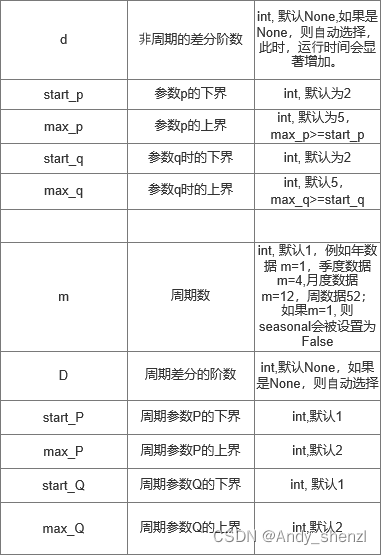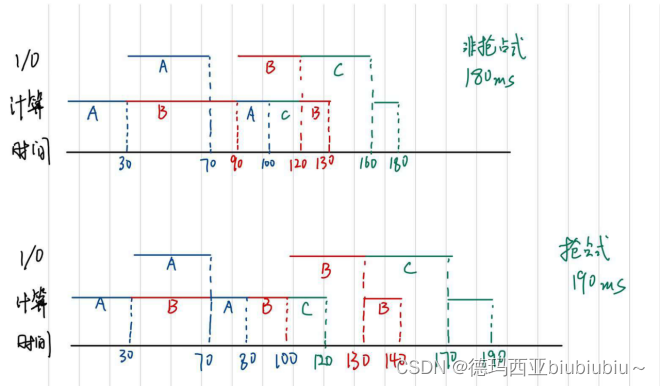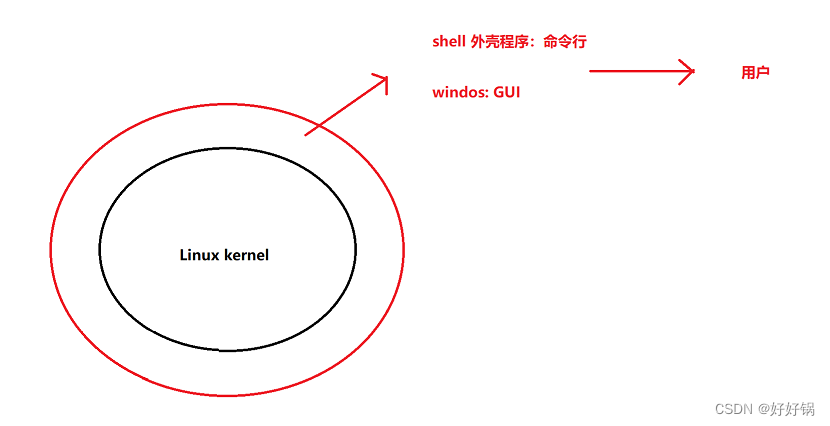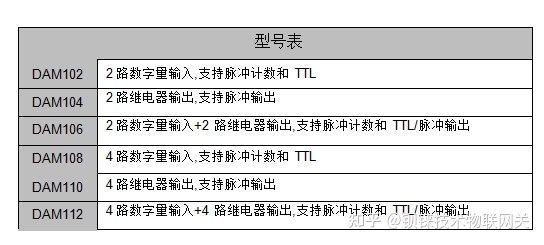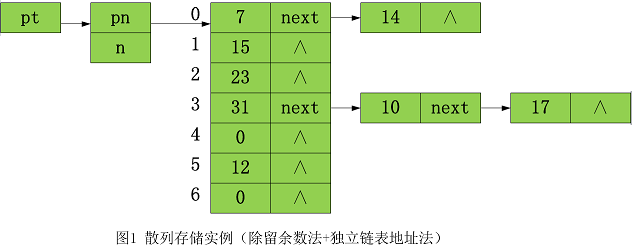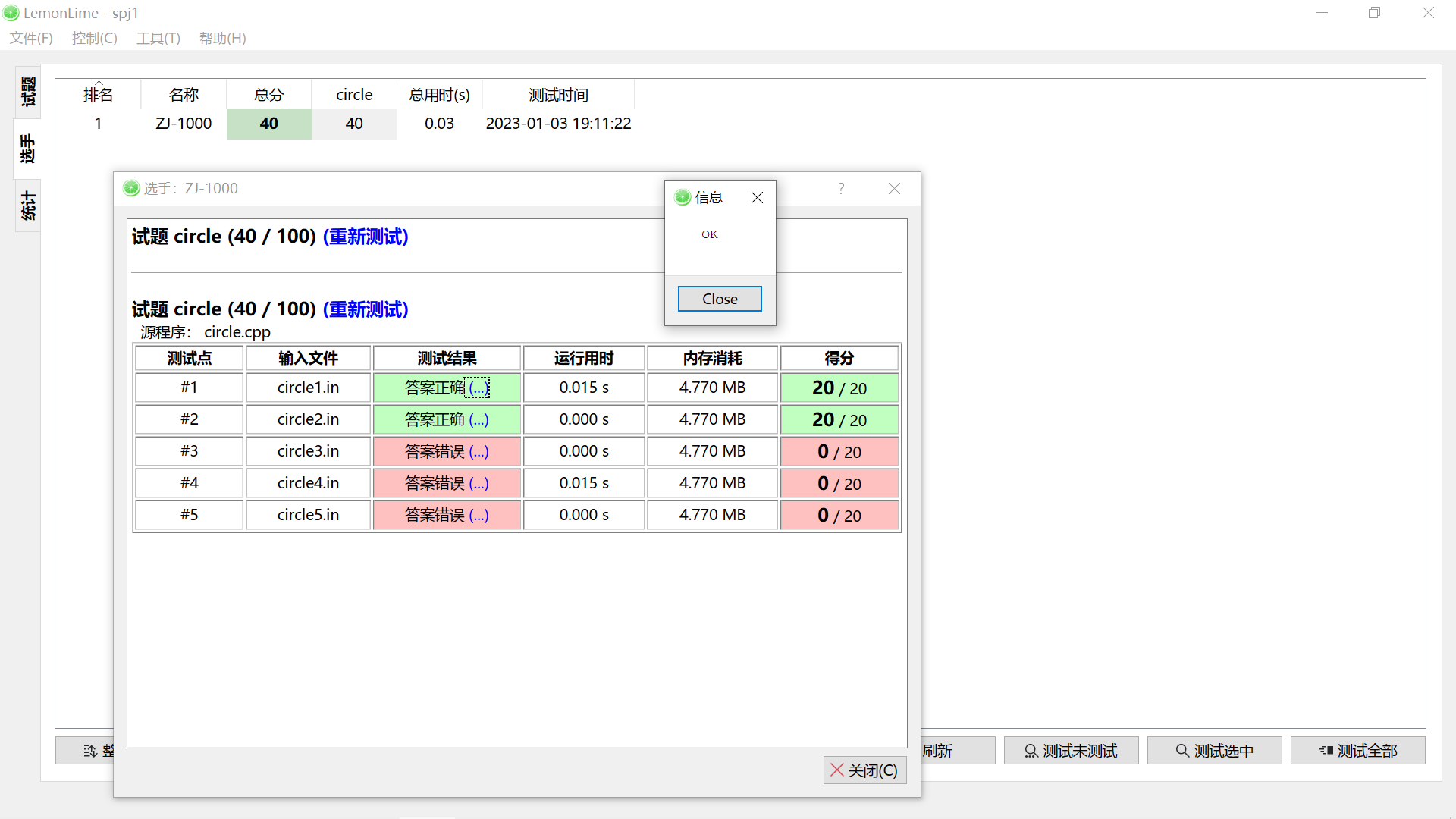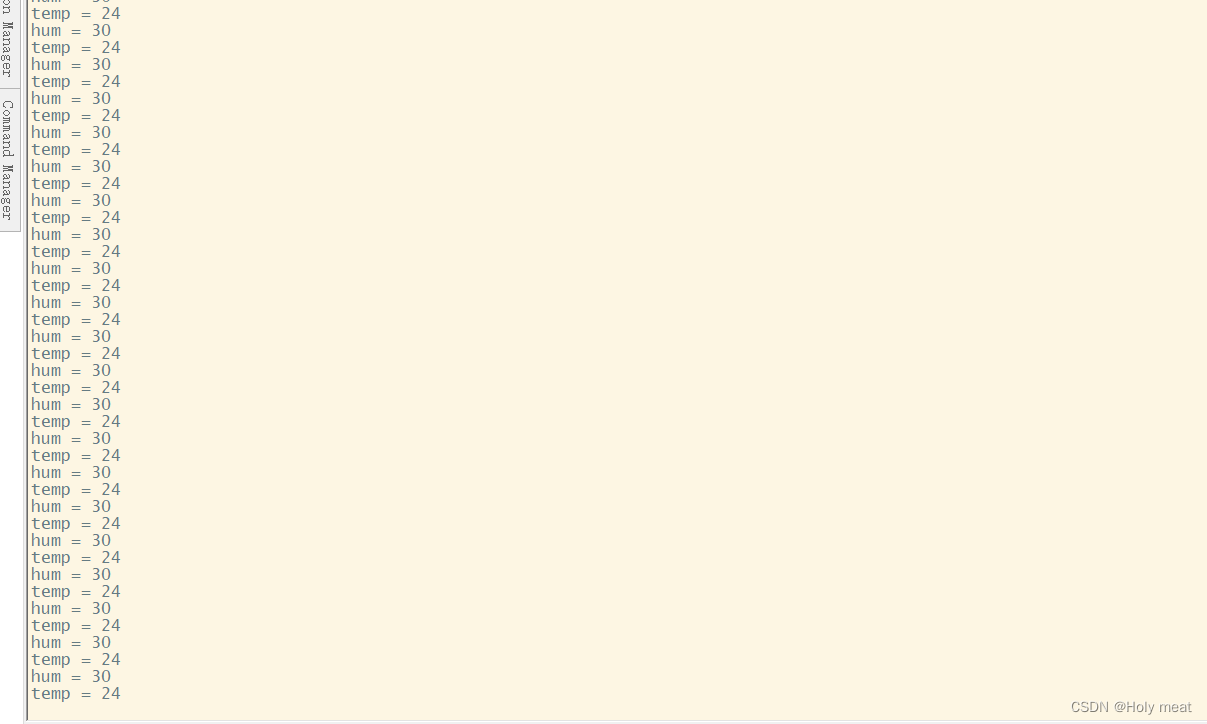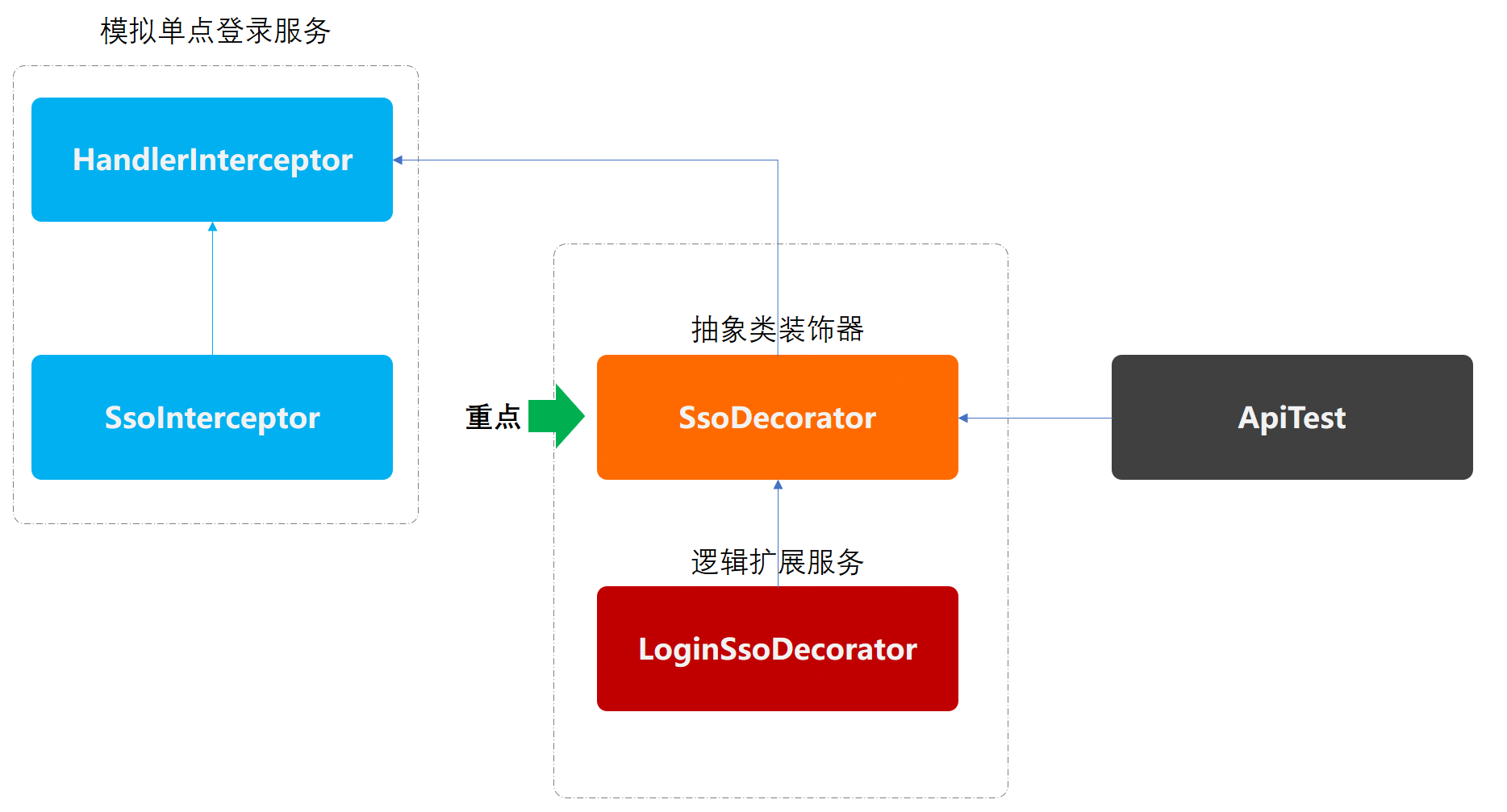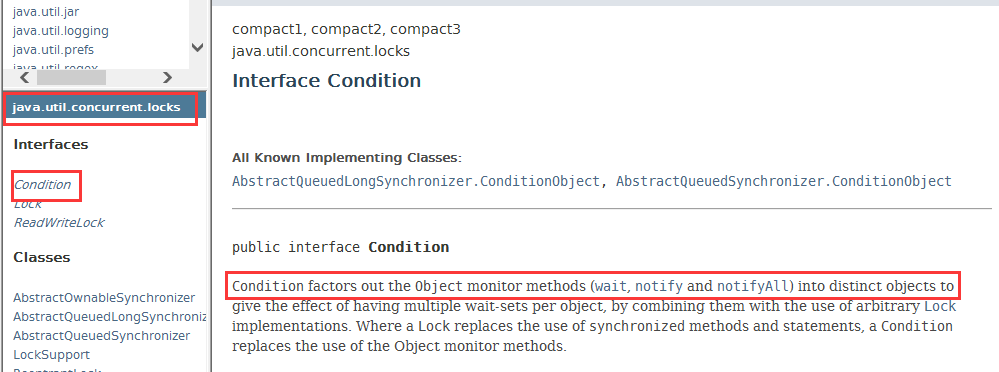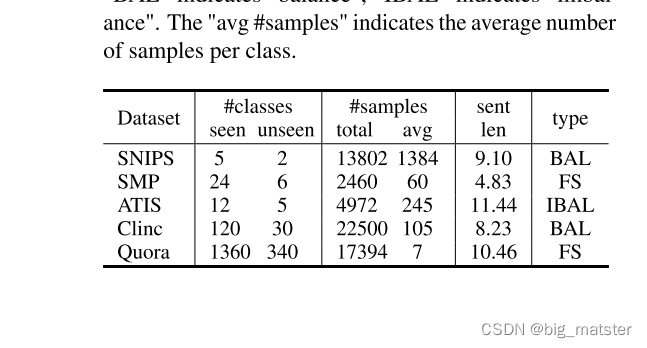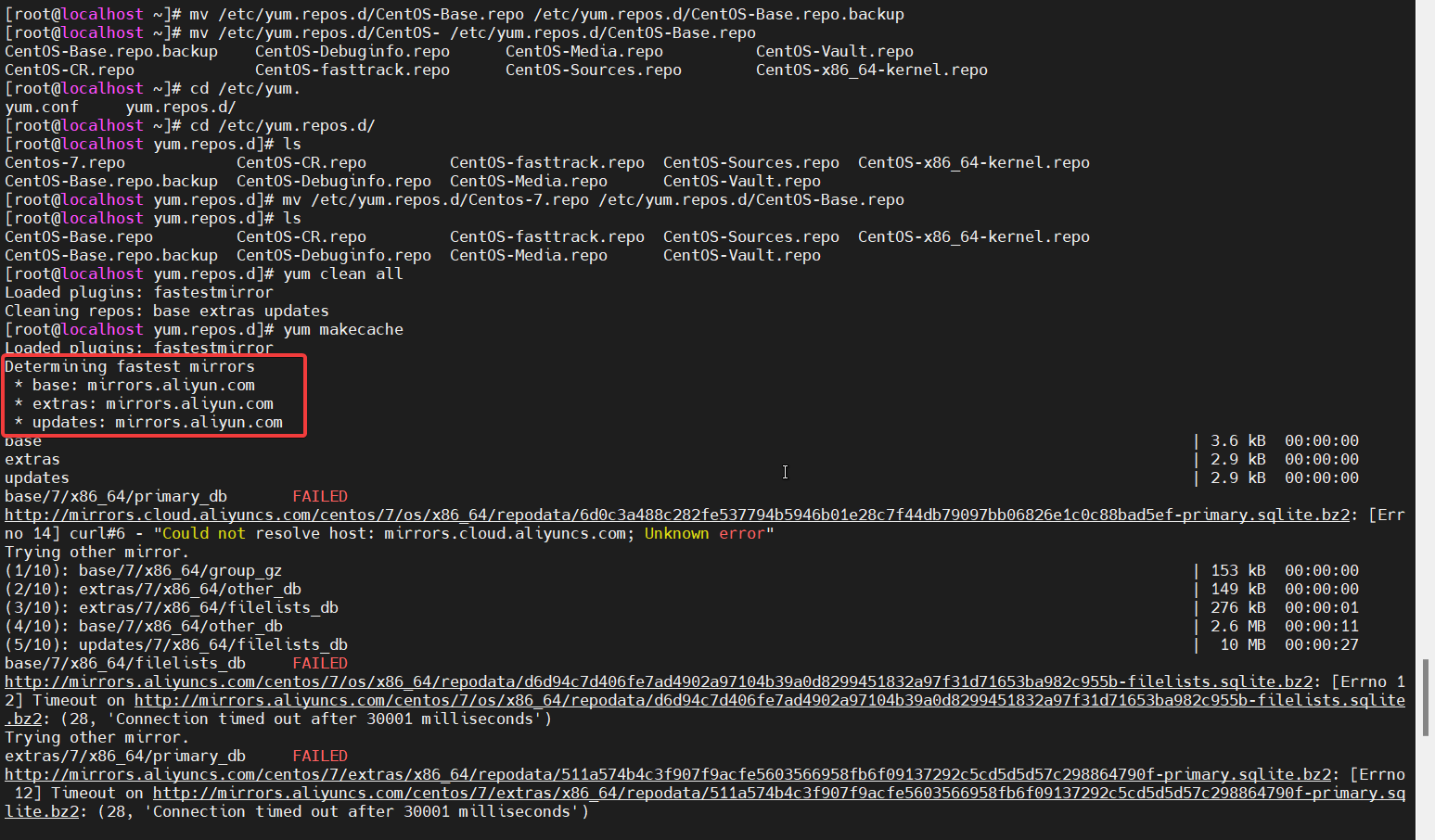一. NIO 基础
non-blocking io 非阻塞 IO
1. 三大组件
1.1 Channel & Buffer
channel 有一点类似于 stream,它就是读写数据的双向通道,可以从 channel 将数据读入 buffer,也可以将 buffer 的数据写入 channel,而之前的 stream 要么是输入,要么是输出,channel 比 stream 更为底层
常见的 Channel 有
- FileChannel
- DatagramChannel
- SocketChannel
- ServerSocketChannel
buffer 则用来缓冲读写数据,常见的 buffer 有
- ByteBuffer
- MappedByteBuffer
- DirectByteBuffer
- HeapByteBuffer
- ShortBuffer
- IntBuffer
- LongBuffer
- FloatBuffer
- DoubleBuffer
- CharBuffer
1.2 Selector
selector 单从字面意思不好理解,需要结合服务器的设计演化来理解它的用途
多线程版设计
⚠️ 多线程版缺点
- 内存占用高
- 线程上下文切换成本高
- 只适合连接数少的场景
线程池版设计
⚠️ 线程池版缺点
- 阻塞模式下,线程仅能处理一个 socket 连接
- 仅适合短连接场景
selector 版设计
selector 的作用就是配合一个线程来管理多个 channel,获取这些 channel 上发生的事件,这些 channel 工作在非阻塞模式下,不会让线程吊死在一个 channel 上。适合连接数特别多,但流量低的场景(low traffic)
调用 selector 的 select() 会阻塞直到 channel 发生了读写就绪事件,这些事件发生,select 方法就会返回这些事件交给 thread 来处理
2. ByteBuffer
有一普通文本文件 data.txt,内容为
1234567890abcd
使用 FileChannel 来读取文件内容
@Slf4j
public class ChannelDemo1 {
public static void main(String[] args) {
try (RandomAccessFile file = new RandomAccessFile("helloword/data.txt", "rw")) {
FileChannel channel = file.getChannel();
ByteBuffer buffer = ByteBuffer.allocate(10);
do {
// 向 buffer 写入
int len = channel.read(buffer);
log.debug("读到字节数:{}", len);
if (len == -1) {
break;
}
// 切换 buffer 读模式
buffer.flip();
while(buffer.hasRemaining()) {
log.debug("{}", (char)buffer.get());
}
// 切换 buffer 写模式
buffer.clear();
} while (true);
} catch (IOException e) {
e.printStackTrace();
}
}
}
输出
10:39:03 [DEBUG] [main] c.i.n.ChannelDemo1 - 读到字节数:10
10:39:03 [DEBUG] [main] c.i.n.ChannelDemo1 - 1
10:39:03 [DEBUG] [main] c.i.n.ChannelDemo1 - 2
10:39:03 [DEBUG] [main] c.i.n.ChannelDemo1 - 3
10:39:03 [DEBUG] [main] c.i.n.ChannelDemo1 - 4
10:39:03 [DEBUG] [main] c.i.n.ChannelDemo1 - 5
10:39:03 [DEBUG] [main] c.i.n.ChannelDemo1 - 6
10:39:03 [DEBUG] [main] c.i.n.ChannelDemo1 - 7
10:39:03 [DEBUG] [main] c.i.n.ChannelDemo1 - 8
10:39:03 [DEBUG] [main] c.i.n.ChannelDemo1 - 9
10:39:03 [DEBUG] [main] c.i.n.ChannelDemo1 - 0
10:39:03 [DEBUG] [main] c.i.n.ChannelDemo1 - 读到字节数:4
10:39:03 [DEBUG] [main] c.i.n.ChannelDemo1 - a
10:39:03 [DEBUG] [main] c.i.n.ChannelDemo1 - b
10:39:03 [DEBUG] [main] c.i.n.ChannelDemo1 - c
10:39:03 [DEBUG] [main] c.i.n.ChannelDemo1 - d
10:39:03 [DEBUG] [main] c.i.n.ChannelDemo1 - 读到字节数:-1
2.1 ByteBuffer 正确使用姿势
- 向 buffer 写入数据,例如调用 channel.read(buffer)
- 调用 flip() 切换至读模式
- 从 buffer 读取数据,例如调用 buffer.get()
- 调用 clear() 或 compact() 切换至写模式
- 重复 1~4 步骤
2.2 ByteBuffer 结构
ByteBuffer 有以下重要属性
- capacity
- position
- limit
一开始

写模式下,position 是写入位置,limit 等于容量,下图表示写入了 4 个字节后的状态

flip 动作发生后,position 切换为读取位置,limit 切换为读取限制
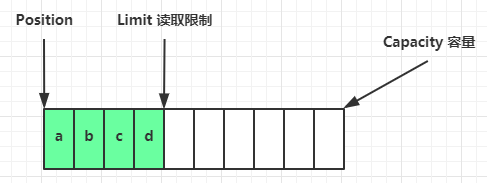
读取 4 个字节后,状态

clear 动作发生后,状态

compact 方法,是把未读完的部分向前压缩,然后切换至写模式

💡 调试工具类
public class ByteBufferUtil {
private static final char[] BYTE2CHAR = new char[256];
private static final char[] HEXDUMP_TABLE = new char[256 * 4];
private static final String[] HEXPADDING = new String[16];
private static final String[] HEXDUMP_ROWPREFIXES = new String[65536 >>> 4];
private static final String[] BYTE2HEX = new String[256];
private static final String[] BYTEPADDING = new String[16];
static {
final char[] DIGITS = "0123456789abcdef".toCharArray();
for (int i = 0; i < 256; i++) {
HEXDUMP_TABLE[i << 1] = DIGITS[i >>> 4 & 0x0F];
HEXDUMP_TABLE[(i << 1) + 1] = DIGITS[i & 0x0F];
}
int i;
// Generate the lookup table for hex dump paddings
for (i = 0; i < HEXPADDING.length; i++) {
int padding = HEXPADDING.length - i;
StringBuilder buf = new StringBuilder(padding * 3);
for (int j = 0; j < padding; j++) {
buf.append(" ");
}
HEXPADDING[i] = buf.toString();
}
// Generate the lookup table for the start-offset header in each row (up to 64KiB).
for (i = 0; i < HEXDUMP_ROWPREFIXES.length; i++) {
StringBuilder buf = new StringBuilder(12);
buf.append(NEWLINE);
buf.append(Long.toHexString(i << 4 & 0xFFFFFFFFL | 0x100000000L));
buf.setCharAt(buf.length() - 9, '|');
buf.append('|');
HEXDUMP_ROWPREFIXES[i] = buf.toString();
}
// Generate the lookup table for byte-to-hex-dump conversion
for (i = 0; i < BYTE2HEX.length; i++) {
BYTE2HEX[i] = ' ' + StringUtil.byteToHexStringPadded(i);
}
// Generate the lookup table for byte dump paddings
for (i = 0; i < BYTEPADDING.length; i++) {
int padding = BYTEPADDING.length - i;
StringBuilder buf = new StringBuilder(padding);
for (int j = 0; j < padding; j++) {
buf.append(' ');
}
BYTEPADDING[i] = buf.toString();
}
// Generate the lookup table for byte-to-char conversion
for (i = 0; i < BYTE2CHAR.length; i++) {
if (i <= 0x1f || i >= 0x7f) {
BYTE2CHAR[i] = '.';
} else {
BYTE2CHAR[i] = (char) i;
}
}
}
/**
* 打印所有内容
* @param buffer
*/
public static void debugAll(ByteBuffer buffer) {
int oldlimit = buffer.limit();
buffer.limit(buffer.capacity());
StringBuilder origin = new StringBuilder(256);
appendPrettyHexDump(origin, buffer, 0, buffer.capacity());
System.out.println("+--------+-------------------- all ------------------------+----------------+");
System.out.printf("position: [%d], limit: [%d]\n", buffer.position(), oldlimit);
System.out.println(origin);
buffer.limit(oldlimit);
}
/**
* 打印可读取内容
* @param buffer
*/
public static void debugRead(ByteBuffer buffer) {
StringBuilder builder = new StringBuilder(256);
appendPrettyHexDump(builder, buffer, buffer.position(), buffer.limit() - buffer.position());
System.out.println("+--------+-------------------- read -----------------------+----------------+");
System.out.printf("position: [%d], limit: [%d]\n", buffer.position(), buffer.limit());
System.out.println(builder);
}
private static void appendPrettyHexDump(StringBuilder dump, ByteBuffer buf, int offset, int length) {
if (isOutOfBounds(offset, length, buf.capacity())) {
throw new IndexOutOfBoundsException(
"expected: " + "0 <= offset(" + offset + ") <= offset + length(" + length
+ ") <= " + "buf.capacity(" + buf.capacity() + ')');
}
if (length == 0) {
return;
}
dump.append(
" +-------------------------------------------------+" +
NEWLINE + " | 0 1 2 3 4 5 6 7 8 9 a b c d e f |" +
NEWLINE + "+--------+-------------------------------------------------+----------------+");
final int startIndex = offset;
final int fullRows = length >>> 4;
final int remainder = length & 0xF;
// Dump the rows which have 16 bytes.
for (int row = 0; row < fullRows; row++) {
int rowStartIndex = (row << 4) + startIndex;
// Per-row prefix.
appendHexDumpRowPrefix(dump, row, rowStartIndex);
// Hex dump
int rowEndIndex = rowStartIndex + 16;
for (int j = rowStartIndex; j < rowEndIndex; j++) {
dump.append(BYTE2HEX[getUnsignedByte(buf, j)]);
}
dump.append(" |");
// ASCII dump
for (int j = rowStartIndex; j < rowEndIndex; j++) {
dump.append(BYTE2CHAR[getUnsignedByte(buf, j)]);
}
dump.append('|');
}
// Dump the last row which has less than 16 bytes.
if (remainder != 0) {
int rowStartIndex = (fullRows << 4) + startIndex;
appendHexDumpRowPrefix(dump, fullRows, rowStartIndex);
// Hex dump
int rowEndIndex = rowStartIndex + remainder;
for (int j = rowStartIndex; j < rowEndIndex; j++) {
dump.append(BYTE2HEX[getUnsignedByte(buf, j)]);
}
dump.append(HEXPADDING[remainder]);
dump.append(" |");
// Ascii dump
for (int j = rowStartIndex; j < rowEndIndex; j++) {
dump.append(BYTE2CHAR[getUnsignedByte(buf, j)]);
}
dump.append(BYTEPADDING[remainder]);
dump.append('|');
}
dump.append(NEWLINE +
"+--------+-------------------------------------------------+----------------+");
}
private static void appendHexDumpRowPrefix(StringBuilder dump, int row, int rowStartIndex) {
if (row < HEXDUMP_ROWPREFIXES.length) {
dump.append(HEXDUMP_ROWPREFIXES[row]);
} else {
dump.append(NEWLINE);
dump.append(Long.toHexString(rowStartIndex & 0xFFFFFFFFL | 0x100000000L));
dump.setCharAt(dump.length() - 9, '|');
dump.append('|');
}
}
public static short getUnsignedByte(ByteBuffer buffer, int index) {
return (short) (buffer.get(index) & 0xFF);
}
}
2.3 ByteBuffer 常见方法
分配空间
可以使用 allocate 方法为 ByteBuffer 分配空间,其它 buffer 类也有该方法
Bytebuffer buf = ByteBuffer.allocate(16);
向 buffer 写入数据
有两种办法 : int readBytes = channel.read(buf); 和 buf.put((byte)127);
- 调用 channel 的 read 方法
- 调用 buffer 自己的 put 方法
@Test
public void testByteBufferWrite() {
ByteBuffer buffer = ByteBuffer.allocate(16);
// 添加元素
buffer.put(new byte[]{'a', 'b', 'c', 'd', 'e'});
try {
// 切换读模式
// TODO : 读数据仅仅只是读, 不是取, 读之后, buf 中的数据依然存在
buffer.flip();
for (int i = 0; i < 4; i++) {
// 使用get时, 指针会一直从 position的位置向limit移动
byte b = buffer.get();
log.debug("{}", b);
// 可以调用 rewind 方法将 position 重新置为 0, 这样读取的一致是0位置的数据
// 或者调用 get(int i) 方法获取索引 i 的内容,它不会移动读指针
buffer.rewind();
}
} catch (BufferUnderflowException e) {
e.printStackTrace();
}
}
从 buffer 读取数据
同样有两种办法
- 调用 channel 的 write 方法
- 调用 buffer 自己的 get 方法
int writeBytes = channel.write(buf);
和
byte b = buf.get();
get 方法会让 position 读指针向后走,如果想重复读取数据
- 可以调用 rewind 方法将 position 重新置为 0
- 或者调用 get(int i) 方法获取索引 i 的内容,它不会移动读指针
mark 和 reset
mark 是在读取时,做一个标记,即使 position 改变,只要调用 reset 就能回到 mark 的位置
注意
rewind 和 flip 都会清除 mark 位置
/**
* TODO mark 是在读取时,做一个标记,即使 position 改变,只要调用 reset 就能回到 mark 的位置
*/
@Test
public void testBufferWritePosition() {
ByteBuffer buffer = ByteBuffer.allocate(16);
// 添加元素
buffer.put(new byte[]{'a', 'b', 'c', 'd', 'e'});
try {
// 切换读模式
buffer.flip();
for (int i = 0; i < 30; i++) {
// 在 初始的 position = 0 这个位置做一个标记 在 0 ~ 2区间读取
if (buffer.position() == 0) {
buffer.mark();
}
log.debug("{}", (char) buffer.get());
// 重置
if (buffer.position() > 2) {
buffer.reset();
}
}
} catch (BufferUnderflowException e) {
e.printStackTrace();
}
}
12:20:48.193 [main] DEBUG cn.knightzz.netty.nio.buffer.ByteBufferMethod - a
12:20:48.196 [main] DEBUG cn.knightzz.netty.nio.buffer.ByteBufferMethod - b
12:20:48.196 [main] DEBUG cn.knightzz.netty.nio.buffer.ByteBufferMethod - c
12:20:48.196 [main] DEBUG cn.knightzz.netty.nio.buffer.ByteBufferMethod - a
12:20:48.196 [main] DEBUG cn.knightzz.netty.nio.buffer.ByteBufferMethod - b
12:20:48.196 [main] DEBUG cn.knightzz.netty.nio.buffer.ByteBufferMethod - c
12:20:48.196 [main] DEBUG cn.knightzz.netty.nio.buffer.ByteBufferMethod - a
12:20:48.196 [main] DEBUG cn.knightzz.netty.nio.buffer.ByteBufferMethod - b
12:20:48.196 [main] DEBUG cn.knightzz.netty.nio.buffer.ByteBufferMethod - c
12:20:48.196 [main] DEBUG cn.knightzz.netty.nio.buffer.ByteBufferMethod - a
字符串与 ByteBuffer 互转
@Test
public void testBuffer2String() {
// 字符串 => ByteBuffer
// 方式1
ByteBuffer buf01 = StandardCharsets.UTF_8.encode("你好");
// 方式2
ByteBuffer buf02 = Charset.forName("utf-8").encode("你好");
log.debug("{}", buf01); // pos=0 lim=6 cap=11
log.debug("{}", buf02);
// 解码
CharBuffer buf03 = StandardCharsets.UTF_8.decode(buf01);
log.debug("{}", buf03);
log.debug("{}", buf03.toString());
}
输出
12:21:25.244 [main] DEBUG cn.knightzz.netty.nio.buffer.ByteBufferMethod - java.nio.HeapByteBuffer[pos=0 lim=6 cap=11]
12:21:25.247 [main] DEBUG cn.knightzz.netty.nio.buffer.ByteBufferMethod - java.nio.HeapByteBuffer[pos=0 lim=6 cap=11]
12:21:25.248 [main] DEBUG cn.knightzz.netty.nio.buffer.ByteBufferMethod - 你好
12:21:25.248 [main] DEBUG cn.knightzz.netty.nio.buffer.ByteBufferMethod - 你好
⚠️ Buffer 的线程安全
Buffer 是非线程安全的
2.4 Scattering Reads
分散读取,有一个文本文件 3parts.txt
onetwothree
使用如下方式读取,可以将数据填充至多个 buffer
/**
* TODO 分散读取
*/
@Test
public void testScatteringReads() {
String path = ByteBufferReadDemo.class.getClassLoader().getResource("data.txt").getPath();
try (RandomAccessFile file = new RandomAccessFile(path, "rw")) {
FileChannel channel = file.getChannel();
// 创建Buffer
ByteBuffer buf01 = ByteBuffer.allocate(4);
ByteBuffer buf02 = ByteBuffer.allocate(4);
ByteBuffer buf03 = ByteBuffer.allocate(4);
channel.read(new ByteBuffer[]{buf01, buf02, buf03});
buf01.flip();
buf02.flip();
buf03.flip();
while (buf01.hasRemaining()) {
log.debug("{}", (char) buf01.get());
}
log.debug("----------------------------------------\n");
while (buf02.hasRemaining()) {
log.debug("{}", (char) buf02.get());
}
log.debug("---------------------------------------- \n");
while (buf03.hasRemaining()) {
log.debug("{}", (char) buf03.get());
}
} catch (FileNotFoundException e) {
throw new RuntimeException(e);
} catch (IOException e) {
throw new RuntimeException(e);
}
}
结果
12:24:04.090 [main] DEBUG cn.knightzz.netty.nio.buffer.ByteBufferMethod - a
12:24:04.094 [main] DEBUG cn.knightzz.netty.nio.buffer.ByteBufferMethod - s
12:24:04.094 [main] DEBUG cn.knightzz.netty.nio.buffer.ByteBufferMethod - b
12:24:04.094 [main] DEBUG cn.knightzz.netty.nio.buffer.ByteBufferMethod - s
12:24:04.094 [main] DEBUG cn.knightzz.netty.nio.buffer.ByteBufferMethod - ----------------------------------------
12:24:04.094 [main] DEBUG cn.knightzz.netty.nio.buffer.ByteBufferMethod - c
12:24:04.094 [main] DEBUG cn.knightzz.netty.nio.buffer.ByteBufferMethod - s
12:24:04.094 [main] DEBUG cn.knightzz.netty.nio.buffer.ByteBufferMethod - 7
12:24:04.094 [main] DEBUG cn.knightzz.netty.nio.buffer.ByteBufferMethod - 8
12:24:04.094 [main] DEBUG cn.knightzz.netty.nio.buffer.ByteBufferMethod - ----------------------------------------
12:24:04.094 [main] DEBUG cn.knightzz.netty.nio.buffer.ByteBufferMethod - 9
12:24:04.094 [main] DEBUG cn.knightzz.netty.nio.buffer.ByteBufferMethod - 0
12:24:04.094 [main] DEBUG cn.knightzz.netty.nio.buffer.ByteBufferMethod - a
12:24:04.094 [main] DEBUG cn.knightzz.netty.nio.buffer.ByteBufferMethod - a
2.5 Gathering Writes
使用如下方式写入,可以将多个 buffer 的数据填充至 channel
/**
* 测试多个ByteBuffer合并
*/
@Test
public void testGatherWrite() {
String path = ByteBufferMethod.class.getClassLoader().getResource("data.txt").getPath();
try (RandomAccessFile file = new RandomAccessFile(path, "rw")) {
FileChannel channel = file.getChannel();
ByteBuffer buf01 = ByteBuffer.allocate(2);
ByteBuffer buf02 = ByteBuffer.allocate(2);
ByteBuffer buf03 = ByteBuffer.allocate(2);
channel.position(14);
buf01.put(new byte[]{'a', 's'});
buf02.put(new byte[]{'b', 's'});
buf03.put(new byte[]{'c', 's'});
// 切换至写模式
buf01.flip();
buf02.flip();
buf03.flip();
channel.write(new ByteBuffer[]{buf01, buf02, buf03});
} catch (IOException e) {
e.printStackTrace();
}
}
2.6 练习
网络上有多条数据发送给服务端,数据之间使用 \n 进行分隔
但由于某种原因这些数据在接收时,被进行了重新组合,例如原始数据有3条为
- Hello,world\n
- I’m zhangsan\n
- How are you?\n
变成了下面的两个 byteBuffer (黏包,半包)
- Hello,world\nI’m zhangsan\nHo
- w are you?\n
现在要求你编写程序,将错乱的数据恢复成原始的按 \n 分隔的数据
package cn.knightzz.netty.nio.exercise;
import io.netty.buffer.ByteBuf;
import lombok.extern.slf4j.Slf4j;
import java.nio.ByteBuffer;
import static cn.knightzz.netty.nio.buffer.ByteBufferUtil.debugAll;
/**
* @author 王天赐
* @title: TestExercise
* @projectName hm-netty-codes
* @description:
* @website <a href="http://knightzz.cn/">http://knightzz.cn/</a>
* @github <a href="https://github.com/knightzz1998">https://github.com/knightzz1998</a>
* @create: 2023-01-03 11:51
*/
@SuppressWarnings("all")
@Slf4j
public class TestExercise {
public static void main(String[] args) {
ByteBuffer source = ByteBuffer.allocate(32);
source.put("Hello,world\nI'm zhangsan\nHo".getBytes());
split(source);
source.put("w are you?\nhaha!\n".getBytes());
}
private static void split(ByteBuffer source) {
// 切换至读模式
source.flip();
int oldLimit = source.limit();
for (int i = 0; i < oldLimit; i++) {
// 获取一条完整的消息, 然后进行存储
if(source.get(i) == '\n') {
// 将新的完整的消息存入ByteBuffer
// source.position() 是ByteBuffer起始索引, if 一条消息读完, position = 6
// 下一次的 source.position() 就是 6, 可以自己打断点调试下
int len = i + 1 - source.position();
ByteBuffer target = ByteBuffer.allocate(i + 1 - source.position());
// 从source读取, 向target写入
for(int k = 0 ; k < len ; k++) {
target.put(source.get());
}
// 打印target中的内容, 这里用了自己写的一个工具类, 可以自己写一个
debugAll(target);
}
}
// 将未读取的部分向左移动, 覆盖掉已经读取的, 为了和下面的数据进行拼接
source.compact();
}
}
